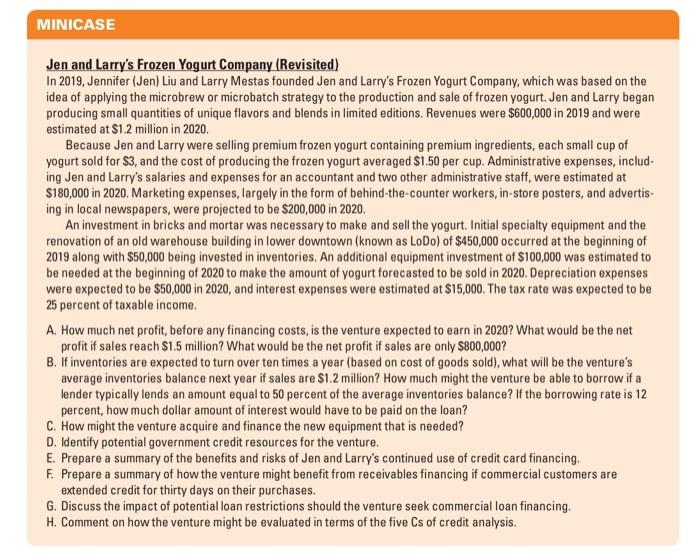Jen and Larry's Frozen Yogurt Company (Revisited) In 2019, Jennifer (Jen) Liu and Larry Mestas founded Jen and Larry's Frozen Yogurt Company, which was based on the idea of applying the microbrew or microbatch strategy to the production and sale of frozen yogurt. Jen and Larry began producing small quantities of unique flavors and blends in limited editions. Revenues were $600,000 in 2019 and were estimated at \$1.2 million in 2020. Because Jen and Larry were selling premium frozen yogurt containing premium ingredients, each small cup of yogurt sold for $3, and the cost of producing the frozen yogurt averaged $1.50 per cup. Administrative expenses, including Jen and Larry's salaries and expenses for an accountant and two other administrative staff, were estimated at $180,000 in 2020. Marketing expenses, largely in the form of behind-the-counter workers, in-store posters, and advertising in local newspapers, were projected to be $200,000 in 2020. An investment in bricks and mortar was necessary to make and sell the yogurt. Initial specialty equipment and the renovation of an old warehouse building in lower downtown (known as LoDo) of $450,000 occurred at the beginning of 2019 along with $50,000 being invested in inventories. An additional equipment investment of $100,000 was estimated to be needed at the beginning of 2020 to make the amount of yogurt forecasted to be sold in 2020. Depreciation expenses were expected to be $50,000 in 2020 , and interest expenses were estimated at $15,000. The tax rate was expected to be 25 percent of taxable income. A. How much net profit, before any financing costs, is the venture expected to earn in 2020 ? What would be the net profit if sales reach $1.5 million? What would be the net profit if sales are only $800,000 ? B. If inventories are expected to turn over ten times a year (based on cost of goods sold), what will be the venture's average inventories balance next year if sales are $1.2 million? How much might the venture be able to borrow if a lender typically lends an amount equal to 50 percent of the average inventories balance? If the borrowing rate is 12 percent, how much dollar amount of interest would have to be paid on the loan? C. How might the venture acquire and finance the new equipment that is needed? D. Identify potential government credit resources for the venture. E. Prepare a summary of the benefits and risks of Jen and Larry's continued use of credit card financing. F. Prepare a summary of how the venture might benefit from receivables financing if commercial customers are extended credit for thirty days on their purchases. G. Discuss the impact of potential loan restrictions should the venture seek commercial loan financing. H. Comment on how the venture might be evaluated in terms of the five Cs of credit analysis







